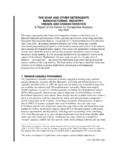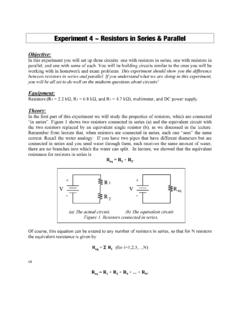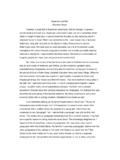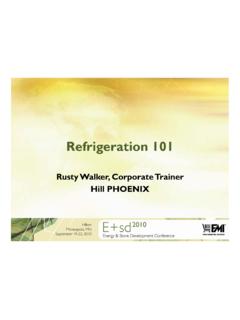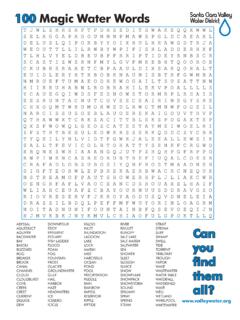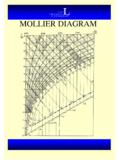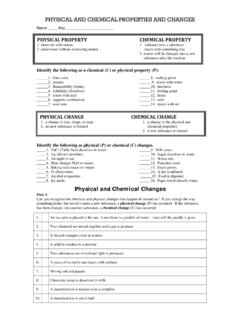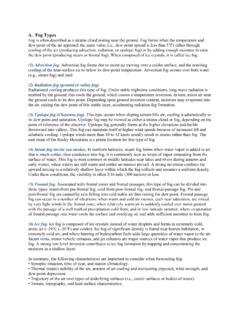Transcription of Crystallization is used to purify a solid. The process ...
1 Crystallization is used to purify a solid. The process requires a suitable solvent. Asuitable solvent is one which readily dissolves the solid (solute) when the solvent is hotbut not when it is cold. The best solvents exhibit a large difference in solubility over areasonable range of temperatures. (eg, water can be a Crystallization solvent between0-100oC; hydrocarbon solvents such as hexanes or petroleum ether have a different Trange since they can be cooled below 0 degrees but boil below 100 degrees). Characteristics of a solvent:a. chosen for solubilizing power-- solubility usually increases with increasing Tb.
2 Polarity is important--like dissolves like; polar compounds are more soluble in polarsolvents; nonpolar compounds in nonpolar solventsc. should be INERT but few are; eg, acetic acid is sometimes used as a solventalthough it will certainly react with basic compoundsd. almost all solvents are COMBUSTABLE--avoid flamese. mixed solvents (eg; 1:1 water /methanol) provide a huge range of possible solventsbut they must be soluble in one anotherQ: Is 95% ethanol a mixed solvent?Use solvent to get solids into solution but to get them out of solution:a. lower the temperature--solute will be less solubleb.
3 Concentrate the solution by removing solvent with a hot plate, heating mantle(flasks), steam bath (use in hood) or with the remove solvent:1. You must have ebullation to concentrate at atmospheric pressure--use a boilingstone, a capillary tube, or If you used reduced pressure to concentrate solution, use the water aspirator with aTRAP in the line. DO NOT turn off the water until the pressure is released. In general,CLAMP any flask that could conceivably trip Do NOT use ebullation if using the Roto-Evaporator. The rotation provides (review)Used to obtain pure crystalline solidUse the proper solvent or solvents--test if necessary; a proper solvent will exhibit a bigsolubility difference over a small temperature or crystallizationa.
4 Use an Erlenmeyer flask, it is specificially designed for this purposeb. dissolve solid in minimum amount of boiling solvent - add solvent in small amounts. For example, if you add 5 mL and approx. half of the solid dissolves, it should take onlyanother 5 mL to dissolve the remaining half. If some of the solid does not are remaining particles your compound or insoluble material (eg, sand, old boilingstones)? d. to determine this, add ca. 10% more hot solvent. If insoluble material, you candecant (carefully transfer solution into another flask leaving the insoluble materialbehind) or if filtering is necessary, do so to remove suspended solids, the faster the better, keepsolution warm so Crystallization does not occur (this may require filtering on a hot plateor other heating device).
5 F. to Adecolorize@, use a small amount of charcoal and filter with Afilter aid@ (see below). For both (e) and (f), rinse filter paper with a small amount of hot let the filtered liquid (filtrate) cool to room temperature slowly in the Erlenmeyer flaskh. cool the filtrate in an ice- water bathi. if crystals have not formed 1. Aseed@ with a small crystal of product, or 2. scratch the flask with a glass rod which has not been fire polished at the end (askfor a demonstration), or 3. add a second solvent dropwise until the Acloud point@ is reached; the cloudinesssuggests that the solute has reached a saturation point in this new mixed solvent andwill start to come out of if material Aoils out@, you must redissolve by heating the solution and then proceedagain from part (g)k.
6 If material precipitates out, it is time to :Most organic compounds are colorless. Highly conjugated compounds (eg, polarpolymers) will absorb light in the visible region of the spectrum and thus be If these highly polar, large molecules are impurities, they can be removed by use offinely granulated activated charcoal (Norit). Polar compounds (eg, polar impurities)adsorb to the charcoal which is insoluble in the solvent and can be filtered away fromsolution. Unfortunately, some of your compound will also adsorb if there is enoughcharcoal so the trick is to use just the right amount.
7 Usually, a very small amount ofcharcoal will suffice (there is a lot of surface to these particles). The Norit is added insmall amounts to the hot (but not boiling) solution until sufficient decolorization hasoccurred. CAUTION--trapped air in the Norit can cause rapid frothing when it hits thehot solution. The Norit can be filtered from the hot solution using fine filter paper or afilter aid (Celite) which is spread on top of the filter paper. To do this, make a slurry ofthe Celite in any solvent. Wet the filter paper and apply suction to make it stick. Nowcarefully pour the Celite slurry onto the filter paper so it evenly covers it.
8 Then applythe suction. You may discard the solvent from the filter flask or change filter flasksprior to filtering the Norit containing to remove insoluble solids suspended in a GRAVITY FILTER FUNNEL when you DON=T want the solidUse a HIRSCH or BUCHNER funnel with vacuum when you do want the solid use a Hirsch or Buchner funnel with a hot solution unless suggested by the Hirsch and Buchner funnels, use a piece of round filter paper which fits thefunnel. A proper fit is a piece of paper that just covers the holes but does not touch thesides of the funnel (ask for a demo).
9 You will need to use reduced pressure, usuallyvia a water aspirator (be certain that the TRAP is clean). For aqueous solutions, youcan use the house vacuum line (be certain that the TRAP is clean).Just prior to pouring the precipitate onto the filter paper, wet the filter paper with a fewmL of solvent and apply the vacuum. This will cause the filter paper to Astick@ to thefilter. For the gravity funnel, you can prepare a suitable filter from round filter paper by foldinginto quarters or by folding it into more than quarters (fluted like a fan). Ask for a demo. Another trick is to use a piece of cotton or glass wool loosely wedged into the cone ofthe funnel.
10 It must be tight enough to not move and to trap the solid particles but looseenough to allow the solution to flow through. This procedure is often used to removedrying agents from the Flasks: For gravity filtration, you can collect the filtrate in any receiver,including the concentration flask you plan to use immediately thereafter. Be certain tosecure the receiver since it will contain your important a Hirsch or Buchner funnel, you will need a filter flask with a sidearm for a rubbertubing connection to the TRAP and the reduced pressure source. Use an appropriatelysized filter flask, one that will not fill more than halfway and secure this flask so that itdoes not tip over with that expensive funnel containing your valuable : For suction filtration, you want a clean glass trap in between your filter flask andthe suction source.
